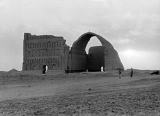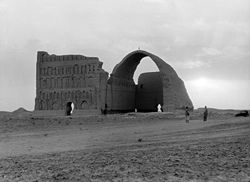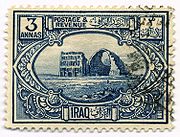
Taq-i Kisra
Encyclopedia




Al-Mada'in
Al-Mada'in, meaning "The cities", is the name given to an ancient metropolis formed by Ctesiphon and Seleucia on opposite sides of the Tigris River in present-day Iraq...
which is the only visible remaining structure of the ancient city of Ctesiphon
Ctesiphon
Ctesiphon, the imperial capital of the Parthian Arsacids and of the Persian Sassanids, was one of the great cities of ancient Mesopotamia.The ruins of the city are located on the east bank of the Tigris, across the river from the Hellenistic city of Seleucia...
. It is near the modern town of Salman Pak
Salman Pak
Salman Pak is a city approximately 15 miles south of Baghdad near a peninsula formed by a broad eastward bend of the Tigris River. It is named after Salman the Persian, a companion of Muhammad who is buried there....
, Iraq
Iraq
Iraq ; officially the Republic of Iraq is a country in Western Asia spanning most of the northwestern end of the Zagros mountain range, the eastern part of the Syrian Desert and the northern part of the Arabian Desert....
.
History
Construction began during the reign of Khosrau IKhosrau I
Khosrau I , also known as Anushiravan the Just or Anushirawan the Just Khosrau I (also called Chosroes I in classical sources, most commonly known in Persian as Anushirvan or Anushirwan, Persian: انوشيروان meaning the immortal soul), also known as Anushiravan the Just or Anushirawan the Just...
after a campaign against the Byzantines in 540 AD. The arched iwan
Iwan
An iwan is a rectangular hall or space, usually vaulted, walled on three sides, with one end entirely open. The formal gateway to the iwan is called pishtaq, a Persian term for a portal projecting from the facade of a building, usually decorated with calligraphy bands, glazed tilework, and...
hall, open on the facade side, was about 37 meters high 26 meters across and 50 meters long, the largest vault
Vault (architecture)
A Vault is an architectural term for an arched form used to provide a space with a ceiling or roof. The parts of a vault exert lateral thrust that require a counter resistance. When vaults are built underground, the ground gives all the resistance required...
ever constructed at the time.
The arch was part of the imperial palace complex. The Throne room—presumably under or behind the arch—was more than 30 m (110 ft) high and covered an area 24 m (80 ft) wide by 48 m (160 ft) long. The top of the arch is about 1 meter thick while the walls at the base are up to 7 meters thick. It was the largest vault ever constructed in Persia. The inverse catenary
Catenary
In physics and geometry, the catenary is the curve that an idealised hanging chain or cable assumes when supported at its ends and acted on only by its own weight. The curve is the graph of the hyperbolic cosine function, and has a U-like shape, superficially similar in appearance to a parabola...
arch was built without centring
Centring
Centring , or centering , is the structure upon which the stones of arches or vault are laid during construction. Once the arch is complete, it supports itself, but until the keystone is inserted, it has no strength and needs the centring to keep the voussoirs in their correct relative...
. In order to make this possible a number of techniques were used. The bricks were laid about 18 degrees from the vertical which allowed them to be partially supported by the rear wall during construction. The quick drying cement used as mortar allowed the fresh bricks to be quickly supported by those that were previously laid.
The Taq-i Kisra is now all that remains above ground of a city that was, for seven centuries, the main capital of the successor dynasties of the Seleucids, Parthia
Parthia
Parthia is a region of north-eastern Iran, best known for having been the political and cultural base of the Arsacid dynasty, rulers of the Parthian Empire....
ns and Sassanids
Sassanid Empire
The Sassanid Empire , known to its inhabitants as Ērānshahr and Ērān in Middle Persian and resulting in the New Persian terms Iranshahr and Iran , was the last pre-Islamic Persian Empire, ruled by the Sasanian Dynasty from 224 to 651...
of Persia. The structure left today was the main portico
Portico
A portico is a porch leading to the entrance of a building, or extended as a colonnade, with a roof structure over a walkway, supported by columns or enclosed by walls...
of the audience hall of the Sassanids who maintained the same site chosen by the Parthians and for the same reason, namely proximity to the Roman Empire whose expansionist aims could be better contained at the point of contact.
The structure was captured and looted by Arabs in AD 637. They then used it as a mosque for a while until the area was gradually abandoned.
In 1888 floods destroyed a third of the ruins.
The monument was in the process of being rebuilt by Saddam Hussein
Saddam Hussein
Saddam Hussein Abd al-Majid al-Tikriti was the fifth President of Iraq, serving in this capacity from 16 July 1979 until 9 April 2003...
's government in the course of the 1980s, when the fallen northern wing was partially rebuilt. All works, however, stopped after the 1991 Persian Gulf War
Gulf War
The Persian Gulf War , commonly referred to as simply the Gulf War, was a war waged by a U.N.-authorized coalition force from 34 nations led by the United States, against Iraq in response to Iraq's invasion and annexation of Kuwait.The war is also known under other names, such as the First Gulf...
. The Iraqi government is cooperating with the University of Chicago
University of Chicago
The University of Chicago is a private research university in Chicago, Illinois, USA. It was founded by the American Baptist Education Society with a donation from oil magnate and philanthropist John D. Rockefeller and incorporated in 1890...
's "Diyala Project" to restore the site.
Alternative names and spellings include: Tâgh-i Kasrâ, Ayvan-e Khosrow, Ayvan-a Kesra, Ayvān-a Kesrā, Ayvān-e Madā'en, Taq-i Khusrau, Taq i Kisra, Iwan-i Kisra, Taq-e Kisra, Tagh-i Kasra, Great arch of Ctesiphon.

